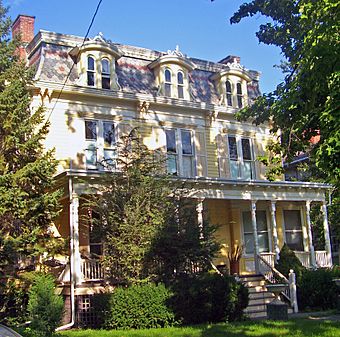Boice House facts for kids
Quick facts for kids |
|
|
Boice House
|
|

West (front) elevation, 2008
|
|
| Location | 110 Fair St., Kingston, New York |
|---|---|
| Area | less than one acre |
| Built | 1850 |
| Architectural style | Greek Revival, Second Empire |
| NRHP reference No. | 01001388 |
| Added to NRHP | December 28, 2001 |
The Boice House is a historic home located on Fair Street in Kingston, New York. It was first built around 1850. The house was designed in the Greek Revival style. This style was popular in the United States during the early to mid-1800s. It often featured elements from ancient Greek temples, like columns and simple, grand shapes.
About 20 years later, a local quarry owner named Hewett Boice bought the house. He decided to update its look. He had the house changed to the popular Second Empire style. This style was common in the late 1800s. It often included fancy details and a special type of roof called a mansard roof. The Boice House was added to the National Register of Historic Places in 2001. This means it is recognized as an important historical building in the United States.
Contents
Discovering the Boice House Design
The Boice House is a large, two-and-a-half-story building. It is made of wood and has a stone and brick base. A two-story section extends from the back. The house stands on the east side of Fair Street. Other historic homes, like the Chichester and William Kenyon houses, are also nearby. They are also listed on the National Register.
The house has a unique mansard roof. This roof is covered with patterned slate tiles. It has an overhanging edge supported by decorative brackets. Round-arched windows, called dormers, stick out from the roof.
Front and Side Views
The front of the house faces west and has five sections. A detailed Victorian porch runs along the entire first floor. On the south side of the house, there is a bay window that sticks out. You can also see parts of what used to be a porte-cochere. This was a covered entrance where carriages could drop off people.
Inside the Historic Home
When you step inside, you enter a central hallway. The ceilings here are made of pressed metal. The walls have special coverings called lincrusta. The lower part of the walls has flat wood panels, known as wainscoting. A beautiful staircase goes up from the side of the hall. A stained glass window lights up the landing of the stairs.
On the first floor, every room has Greek Revival style moldings. These are decorative strips of wood. The living rooms have fancy marble fireplace surrounds. These are in the Italianate style, which was also popular in the 1800s.
Outdoor Features
Around the house, there are several important historical items. Five of these are made from bluestone. Bluestone is a type of stone often found in this area. These items include:
- A block for getting into carriages, with "H. BOICE" carved into it.
- A post for tying up horses.
- Two stone blocks with planters on top.
- A stone walkway.
There is also a former carriage house at the back of the property. This building was once used to store carriages. It has now been changed into a home studio. It is also considered a contributing part of the historic property.
A Glimpse into Boice House History
Records from the late 1800s show that Fair Street was home to many wealthy people in Kingston. The Boice House was likely built around 1850. It was built by Erastus Cooke, who was a local lawyer.
In 1869, Erastus Cooke sold the house to Elizabeth P. Cockburn. She was from Hurley, New York. In 1885, Elizabeth and her husband, William Cockburn, sold the house to Hewitt Boice. Hewitt Boice was a quarry owner. His quarry even supplied some of the stone for the famous Brooklyn Bridge! He bought the house for $7,000. This would be worth much more money today.
Hewitt Boice then updated the house's outside. He gave it a grand Second Empire look. Most of these changes are still visible today.
In 1917, Hewitt Boice's daughter, Virginia Boice Seeley, inherited the house. She later gave it to her stepmother, Katherine Deyo Boice. Katherine remarried and lived in the house until she passed away in 1953. Since then, the Boice House has had several different owners. It is still a private home today.



